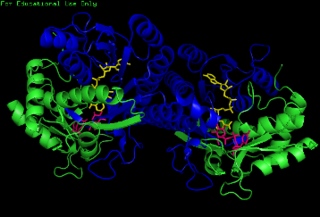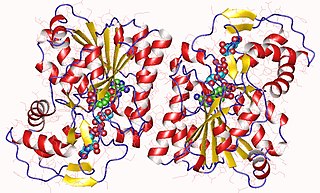
Galactosamine is a hexosamine derived from galactose with the molecular formula C6H13NO5. This amino sugar is a constituent of some glycoprotein hormones such as follicle-stimulating hormone (FSH) and luteinizing hormone (LH).

Uridine diphosphate galactose (UDP-galactose) is an intermediate in the production of polysaccharides. It is important in nucleotide sugars metabolism, and is the substrate for the transferase B4GALT5.

Tunicamycin is a mixture of homologous nucleoside antibiotics that inhibits the UDP-HexNAc: polyprenol-P HexNAc-1-P family of enzymes. In eukaryotes, this includes the enzyme GlcNAc phosphotransferase (GPT), which catalyzes the transfer of N-acetylglucosamine-1-phosphate from UDP-N-acetylglucosamine to dolichol phosphate in the first step of glycoprotein synthesis. Tunicamycin blocks N-linked glycosylation (N-glycans) and treatment of cultured human cells with tunicamycin causes cell cycle arrest in G1 phase. It is used as an experimental tool in biology, e.g. to induce unfolded protein response. Tunicamycin is produced by several bacteria, including Streptomyces clavuligerus and Streptomyces lysosuperificus.

The enzyme UDP-glucose 4-epimerase, also known as UDP-galactose 4-epimerase or GALE, is a homodimeric epimerase found in bacterial, fungal, plant, and mammalian cells. This enzyme performs the final step in the Leloir pathway of galactose metabolism, catalyzing the reversible conversion of UDP-galactose to UDP-glucose. GALE tightly binds nicotinamide adenine dinucleotide (NAD+), a co-factor required for catalytic activity.

In enzymology, an UDP-N-acetylglucosamine 4-epimerase is an enzyme that catalyzes the chemical reaction
In enzymology, an UDP-N-acetylgalactosamine-4-sulfate sulfotransferase is an enzyme that catalyzes the chemical reaction
In enzymology, a glycoprotein-N-acetylgalactosamine 3-beta-galactosyltransferase is an enzyme that catalyzes the chemical reaction
In enzymology, a polypeptide N-acetylgalactosaminyltransferase is an enzyme that catalyzes the chemical reaction
In enzymology, a N-acetylgalactosamine kinase is an enzyme that catalyzes the chemical reaction

Polypeptide N-acetylgalactosaminyltransferase 3 is an enzyme that in humans is encoded by the GALNT3 gene.

Polypeptide N-acetylgalactosaminyltransferase 1 is an enzyme that in humans is encoded by the GALNT1 gene.

Polypeptide N-acetylgalactosaminyltransferase 2 is an enzyme that in humans is encoded by the GALNT2 gene.

Polypeptide N-acetylgalactosaminyltransferase 13 is an enzyme that in humans is encoded by the GALNT13 gene.
(N-acetylneuraminyl)-galactosylglucosylceramide N-acetylgalactosaminyltransferase is an enzyme with systematic name UDP-N-acetyl-D-galactosamine:1-O-(O- - -O-beta-D-galactopyranosyl- -beta-D-glucopyranosyl)-ceramide 4-beta-N-acetyl-D-galactosaminyltransferase. This enzyme catalyses the following chemical reaction:
Beta-1,3-galactosyl-O-glycosyl-glycoprotein beta-1,6-N-acetylglucosaminyltransferase is an enzyme with systematic name UDP-N-acetyl-D-glucosamine:O-glycosyl-glycoprotein 6-beta-N-acetyl-D-glucosaminyltransferase. This enzyme catalyses the following chemical reaction
Acetylgalactosaminyl-O-glycosyl-glycoprotein beta-1,6-N-acetylglucosaminyltransferase (EC 2.4.1.148 with systematic name UDP-N-acetyl-D-glucosamine:N-acetyl-beta-D-glucosaminyl- -N-acetyl-D-galactosaminyl-R 6-beta-N-acetyl-D-glucosaminyltransferase. This enzyme catalyses the following chemical reaction
N-acetylneuraminylgalactosylglucosylceramide beta-1,4-N-acetylgalactosaminyltransferase (EC 2.4.1.165, is an enzyme that catalyses the following chemical reaction:
N,N'-diacetylbacillosaminyl-diphospho-undecaprenol alpha-1,3-N-acetylgalactosaminyltransferase is an enzyme with systematic name UDP-N-acetyl-alpha-D-galactosamine:N,N'-diacetyl-alpha-D-bacillosaminyl-diphospho-tritrans,heptacis-undecaprenol 3-alpha-N-acetyl-D-galactosaminyltransferase. This enzyme catalyses the following chemical reaction
UDP-N-acetylgalactosamine diphosphorylase is an enzyme with systematic name UTP:N-acetyl-alpha-D-galactosamine-1-phosphate uridylyltransferase. This enzyme catalyses the following chemical reaction
Galactosaminogalactan, is an exopolysaccharide composed of galactose and N-acetylgalactosamine (GalNAc). It is commonly found in the biofilm and cell wall of various fungal species. Although the sugar residues are arranged in no particular/discrete order, and thus a heteroglycan, the residues are all linked by α-1,4 glycosidic bonds. Galactosaminogalactan is typically extracted by ethanol precipitation from liquid culture or by alkaline treatment from the cell wall. Once extracted, galactosaminogalactan becomes highly insoluble.








